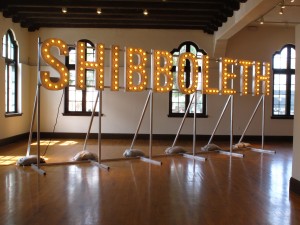Successful Word Play at the Athenaeum
“What’s a signifier, Daddy?”
“Huh? Go ask your mother!”
The arbitrary sounds that each language or even a regional dialect uses to describe something may cause all types of trouble. Ever since that Tower of Babel incident mentioned in the Bible, verbal communication can either unite people or cause animosity between them. The artist Allison Wiese wreaks this same diabolical havoc using mere words in her solo exhibition at the Athenaeum Music and Arts Library in La Jolla.

Allison Weise.
“Shibboleth,” 2014.
Illuminated channel letters sign. 8 x 20 x 6-feet.
Photo by Roy Porello. Image courtesy of the Athenaeum Music and Arts Library, La Jolla.
Wiese’s exhibition Speaking Otherwise is a marvelously wicked take on word play. The main artwork appears to be a gaudy Broadway marquee-sized sign with blinking light bulbs that spells out the word shibboleth. Twenty-four-inch tall, electrified three-dimensional capital letters (known as “channel letters” in the signage trade) have been erected high upon a visually spare eight-foot tall armature, which make the letters appear to float six-feet off the floor. This grand twenty-foot wide artwork, titled “Shibboleth” (2014), has been placed very close to the entrance of the Athenaeum’s main gallery. Upon entering, this makes the structure spatially confrontational and barrier-like.
The word shibboleth has two meanings in ancient Hebrew: “a fresh water stream” and “a strong current of water and/or whirlpool.” The word itself is a prominent feature in a story from the Book of Judges in the Tanakh (Old Testament). In Judges, Chapter 12 (verses 1-15), a tale is told of a battle that occurred when the tribe of Ephraim crossed the River Jordan to ask the tribe of Gilead why the Ephraimites were not enlisted to help in a previous battle between the Gileadites and the kingdom of the Amorites (after the previous battle the Amorites had lost their lands to the Gileadites to share with the other Israelite tribes).
Ergo, a new battle from strange jealousy over how the Amorite spoils were acquired erupted between the Ephraimites and the Gileadites. The Ephraimites lost. After the new battle, the Gileadites posted sentries along the river and made each person trying cross the Jordan say the word “shibboleth.” The word was chosen because the Ephraimite dialect had no “sh” sound, and they would mispronounce shibboleth. As people crossed the river, the sentries told each person to say the word. If they instead said “sibboleth,” the Gileadites knew they were enemy Ephraimites and killed them. The Book of Judges says that 42,000 people died mispronouncing the word!
Ironically, later Greek translators of the Tanakh intentionally omitted shibboleth because the Greeks themselves had no letters in their alphabet that could spell the sound of the word. Those translators instead replaced shibboleth with the word stachys, which means an “an ear of wheat.” That translation continued into the Latin Bible as well as into the 1611 King James Bible, but the King James Version translated stachys as “an ear of corn.” Shibboleth only reappears in the 1885 revised King James Version. Today, in American dictionaries etymologies of Shibboleth state the Hebrew form of “water” while British dictionaries stubbornly state the Greek substitute “an ear of corn/grain” as the original sources for the word—two distinctly different meanings from the same language. This becomes another shibboleth separating our two countries “across the pond” from one another.
There is a brilliant point here that Weise is exploiting since today shibboleth also connotes a commonality between different groups of people or an alienating dissimilarity among them. It also conveys something that has no real truth or meaning behind it. It is doubtful that most people have ever encountered the word let alone know what it means, which makes shibboleth potentially alienating. This proves that Wiese’s “Shibboleth” is functioning positively as an alienating play with words.
Two additional camouflaged aspects are also part of the artwork. One is the wall label in the gallery identifying the artwork and another is Weise’s artist statement. On the wall label to describe “Shibboleth,” the description of the materials says that it has “movement.” In other didactic material the sign is described as having “motion.” Although “movement” and “motion” generally imply being kinetic, here Wiese is injecting jargon used in the signage industry to denote the chasing blinking effect of light bulbs on a sign. She is thus invoking alternative meanings of words because the signage does not actually move—again an analogy to shibboleth because of the confusing and contradicting word meanings.
Within Wiese’s seemingly inelegant written, thus potentially alienating, artist’s statement (again with the shibboleth?), she states: “The word shibboleth is derived from the Hebrew word for the head of a grain plant (some dictionaries offer up “ear of corn,” but I’m guessing this is an anachronism, since corn is a new world crop?).” This statement is key to unraveling Weise’s wacky word game. As I have explained the origin of the word, she is intentionally omitting facts. But most important is the parenthetical aside, “’(…ear of corn,’ but I’m guessing this is an anachronism, since corn is a new world crop?)”.
Corn, in fact, is not a New World crop. The origin of the word corn derives from a generic Middle English term for grain that has been used for, wheat, oats, and barley since the 900s. It relates to the Old Germanic word koren as well and the Gothic term Kaúrn—all words used well before both the original King James Bible and Columbus’s arrival to the New World. The New World crop was a hybrid of Zea mays better known as maize, and the term corn was ascribed by Europeans for the new imported crop dubbed “Indian Corn” from the Americas.
Together, the contradicting wall label, contracting didactics, and her artist statement’s inaccuracies empty the meaningful truth from her words. These facets again scream shibboleth!
Weise’s “Shibboleth” is more than the signage itself. How it is placed is confrontational, which is akin to the biblical battle and also a visual barrier similar to the River Jordan separating the Ephraimites and Gileadites. The intentional use and misuse of the word and its ironic history is reaffirmed in the words used on the wall label, the didactic material, and her artist statement.
All roads circle back to the arbitrary history of the word shibboleth. It is a signifier: an arbitrary word sound used to describe something. Altogether, Wiese’s “Shibboleth” was difficult to decipher. The artwork proved to be a provoking challenge that revealed a multitude of meaningful layers. It engaged, enraged, and frustrated this viewer for two-weeks! The artwork is, indeed, kinetic—not moving—but lively, dynamic, and energizing, which are other alternative meanings to kinetic.
Oh, “Shibboleth”! How much more satisfaction, delight, and challenge could one expect from thinking about and considering ye?
Speaking Otherwise is on exhibition at the Athenaeum Music and Arts Library from 20 September through 1 November 2014.

Kraig Cavanaugh lectures about art history—specializing in Modern & Contemporary Art—as well as being an instructor of color theory, design, and studio art. He has curated numerous art exhibitions, authored exhibition catalogues, and written art reviews for several other print and online journals including “Artweek” (USA) and “Selvedge” (UK) magazines. Cavanaugh is also an invited member of the Association Internationale des Critiques d’Art (United States division), which is an NGO in official relations with UNESCO.


